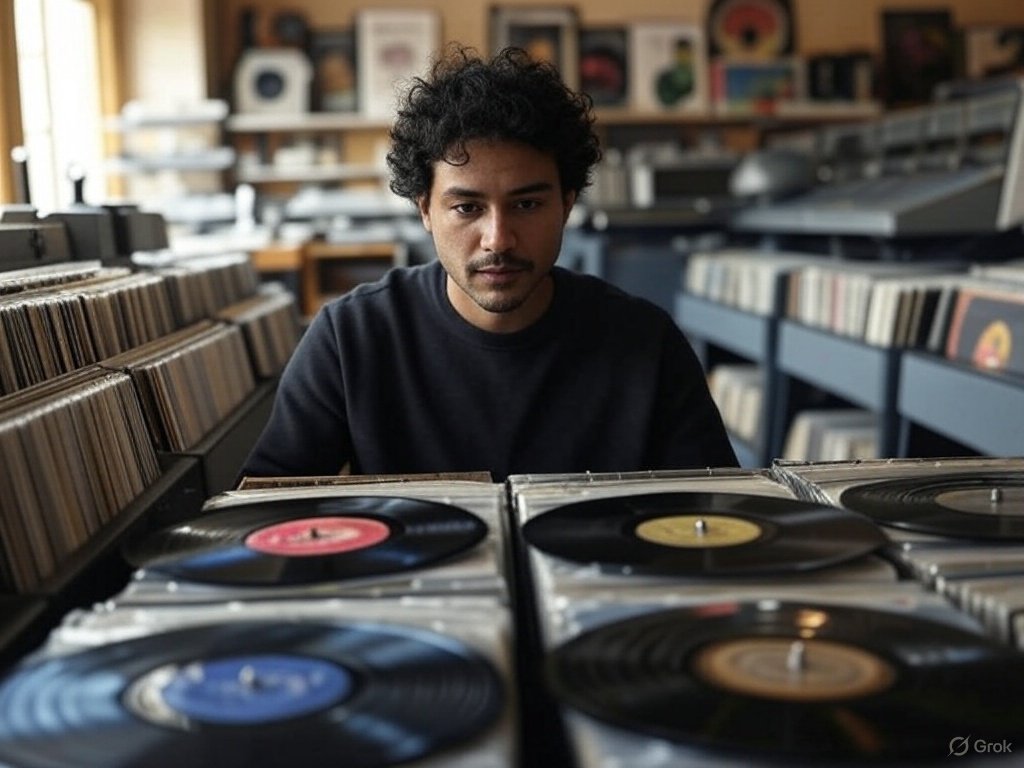Just a decade ago, vinyl records were a niche obsession: pricey imports for audiophiles and dusty relics gathering shelf space in collectors’ basements. Fast-forward to 2025, and the needle is on the rise—vinyl sales now account for over 10 percent of recorded-music revenue in North America, outpacing CD and digital-download income. At the heart of this resurgence is a flourishing ecosystem of boutique pressing plants and agile indie labels that marry artisanal craftsmanship with modern marketing savvy. From custom-color runs to limited-edition “Record-Store Day” exclusives, vinyl has evolved into both a high-fidelity format and a cultural artifact, fueling a renaissance that shows no signs of slowing. Here’s how small-batch pressing and DIY labels are driving vinyl’s comeback—and what it means for artists, collectors, and the wider industry.
The Drivers of Vinyl’s Comeback
Tangibility in a Digital World
In an era dominated by intangible streaming libraries and algorithmic playlists, the tactile nature of vinyl offers a welcome contrast. Holding a 180-gram record, admiring sleeve art, and carefully placing the stylus are rituals that engage all the senses—rituals that fans say deepen their connection to the music.
Collector Culture and Limited Runs
Boutique pressing plants routinely produce small runs—100 to 500 copies—of colored vinyl, picture discs, or even cassette/vinyl hybrid releases. Scarcity fuels demand: limited-edition pressings sell out in minutes, and aftermarket resale often doubles original prices. Platforms like Discogs and StockX facilitate secure secondary-market transactions, legitimizing vinyl as an investment asset alongside art prints and trading cards.
Artist and Label Strategies
Indie labels leverage vinyl as a premium offering, bundling records with digital downloads, lyric inserts, and exclusive merch. Fan-club memberships often include early-access LPs or personalized colored-vinyl variants, rewarding superfans and generating predictable revenue through subscriptions.
The Rise of Boutique Pressing Plants
A New Wave of Micro-Presses
Demand for vinyl has outpaced the capacity of legacy plants, leading to long lead times—six to nine months from lacquer to release. Enter micro-presses: compact, European-made machines (like the Newbilt K2 and GZ Media’s desktop units) that enable local studios and labels to handle short runs on-site. These systems:
- Offer Rapid Turnaround: Small batches can be pressed in weeks rather than months, crucial for independent artists wanting to capitalize on digital buzz.
- Enhance Customization: Pressing at 45 RPM, employing tri-color vinyl, or embedding “hidden” color swirls become feasible without prohibitive mold-change fees.
- Reduce Carbon Footprint: Localized pressing cuts down on transoceanic shipping of heavy vinyl slabs, aligning with sustainability goals.
Collaboration Between Presses and Artists
Pressing plants collaborate directly with artists and designers to produce hand-numbered editions, deluxe gatefold sleeves, and UV-print covers. Specialists like Chicago’s Gotta Groove Records and Berlin’s Manmade Mastering have cultivated reputations for quality control, color-matching precision, and innovative packaging—becoming partners rather than mere vendors.
Indie Labels as Vinyl Visionaries
Lean Operations, Tight Budgets
Without massive overheads, indie labels can take creative risks: releasing experimental genres, local-scene compilations, or archival reissues of obscure cult acts. Labels like Light in the Attic and Numero Group have thrived by excavating lost gems—pressing them on heavyweight vinyl with lovingly curated liner notes.
Direct-to-Fan Sales
E-commerce platforms integrated into label websites enable pre-orders and exclusive variant drops. Direct-to-fan models bypass traditional distributors, yielding higher margins and richer customer data—vital for planning reorders and tour tie-ins.
Community-Driven Marketing
Labels engage local record stores for in-person listening parties, exclusive “label nights,” and pop-up events. Social-media teasers reveal test-press images, gauge fan-favorite colorways, and invite followers to vote on B-side selections, crowdsourcing both hype and product development.
The Economic and Cultural Impact
Revitalizing Record Stores
The vinyl boom has rejuvenated independent record stores, which saw foot traffic decline through the 2010s. Today, monthly “Record-Store Day” events draw crowds at dawn, eager for exclusive releases. Stores host live in-store performances, DJ sets, and swap meets for used vinyl—cementing their role as community hubs.
Skill Preservation and Job Creation
New pressing facilities and indie mastering studios have generated skilled-labor opportunities: lathe engineers, plant technicians, sleeve-design artists, and mastering specialists. Apprenticeship programs at established plants ensure craft knowledge passes to the next generation.
Sustainability Concerns
Vinyl production is energy-intensive and relies on PVC, a petroleum-based plastic. In response, some presses are experimenting with recycled vinyl pellets and bio-PVC alternatives. Others offset carbon via solar-powered plants or tree-planting partnerships, acknowledging that environmental stewardship must accompany cultural growth.
Challenges and Future Directions
Scaling Without Sacrificing Quality
As demand soars, boutique presses must balance capacity expansion with quality control. Overloading small presses can introduce defects—warps, non-fill, and surface noise—undermining consumer trust. Strategic partnerships between micro-presses and regional mega-plants help alleviate pressure without commoditizing craftsmanship.
Innovating Beyond Traditional Formats
Some labels and presses explore hybrid formats—vinyl paired with USB decks, holographic sleeve art, or audiovisual synchronization via QR codes. These innovations aim to enhance the analog experience rather than replace it, integrating vinyl into multimedia ecosystems.
Maintaining Accessibility
Limited-edition runs can exclude casual fans priced out by collector premiums. To address this, labels often offer standard black-vinyl editions alongside premium variants, ensuring core releases remain affordable.
Conclusion
Vinyl’s revival in 2025 is more than a nostalgic fad—it’s a vibrant subindustry powered by boutique pressing plants, nimble indie labels, and passionate communities. The juggernaut of streaming has not eclipsed analog affection; rather, it has sharpened the desire for tactile, intentional music experiences. As new presses sprout, labels experiment with packaging and formats, and collectors hunt rare variants, vinyl stands as a testament to the enduring power of physical media. Whether you’re hunting a hand-numbered color-splash variant or spinning a classic rock reissue, the vinyl renaissance ensures that, in a digital age, the analog heartbeat still resonates—loud, warm, and alive.





